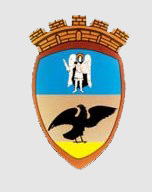

Tarashcha, Ukraine
Тараща, Yкраïна
טאראשטשע


Tarashcha, Ukraine
Тараща, Yкраïна
טאראשטשע

History
|
In 1611 the remote settlement of Tarashcha was granted to the landowner Lesovich of Bila Tserkov castle, a member of the Russian aristocracy, in return for military service. A century later, in 1709, the land in and around Tarashcha was granted to a Colonel Blindavsky by Augustus II, king of the Polish-Lithuanian Commonwealth, as a reward for his courage in the Great Northern War (1700-1721) against the Swedes. The Khmelnytsky Uprising began in January 1648 in response to Polish rule of the Ukraine. Social and religious motives underlay the revolt - Poles were Catholic, whereas Ukrainians were Orthodox; and the Ukrainians resented Polish control of Ukrainian lands. The Cossacks and peasants joined together in attacking both the Polish nobility and their Jewish agents. There were at least two occasions when Khmelnytsky's forces were in Bila Tserkov - within striking distance of Tarashcha; it is not unreasonable to assume that any Jews living in or around Tarashcha would have experienced the savagery of Khmelnytsky's minions. The destruction of Jewish life and property was so severe that Jews at the time considered the losses comparable to the destruction of the first and second temples. Even more than two hundred and fifty years later, the memory of these events were still palpable; this web designer's mother made references to Khmelnytsky whenever she recalled her own experiences during the Russian Civil War! Nevertheless, the Jewish communities west of the Dniepr River were rebuilt. Jews who had escaped the killing returned to the Ukraine. In time, the Ukraine became one of the most densely populated Jewish regions in the world. Tarashcha became a town under the auspices of King Augustus II in 1722, who also granted it Magdeburg Rights. These were German medieval town laws that benefited local merchants and artisans through the regulation of trade. During the eighteen years following 1722, Tarashcha grew from a village to a regional center under the control of a starosta (i.e., provincial administrator) in the Polish-Lithuanian Commonwealth. This starosta, the Elder Pjaskovsky, owned Tarashcha for his lifetime. However, the year 1791 saw Tarashcha taken from private hands. Some time later, Tarashcha became a mestechko - a small village - when the Kiev Province was formed. In 1801 Tarashcha again attained the status of a town. The Polish-Lithuanian Commonwealth had been, in effect, a Russian protectorate at least since 1709. In that year, Peter the Great supported the return of Augustus II to the Polish throne after Augustus' defeat at the hands of the Swedes. The previous year saw administrative reforms under the auspices of Peter the Great that led to the establishment of the Kiev Gubernia, which then consisted of all of Eastern Ukraine (including Tarashcha) and a large part of Central Russia. This outsized territory was pared back twice, once in 1781 and again in 1795, as part of the Third Polish Partition. |
The Kiev Gubernia had earlier been annexed into the Russian Empire as a result of the Second Polish Partition of 1793. The year 1768 saw the poor of Tarashcha participate in the peasant and cossack Koliivshcina uprising, which was the largest and bloodiest of several Haidamaka uprisings that occurred in the eighteenth century. Motivated by perceived abuse of power by Polish magnates and their Jewish stewards, by the hope of abolishing serfdom, and by a desire to freely practice the Orthodox faith, peasants and cossacks captured many towns, slaughtering the Polish and Jewish inhabitants. The Pale of Settlement was established by Catherine the Great in 1791 to isolate the Jews from the wider Slavic culture. There was a strong desire among Slavs to have a "pure", monolithic culture with a common religion, language, and ethos untainted by Jews. Also, economic forces unleashed by the partitions of Poland and the consequent decline of the Polish nobility led to restrictions on Jewish economic opportunities. The Jewish population also preferred to maintain their distinct cultural and religious identity and to continue their traditional residence in the villages of the Pale. Czar Alexander I, however, promulgated, in 1804, the Statute Concerning the Organization of the Jews designed to expel them from the villages and to force their assimilation. This decree, as well as others, was successfully resisted throughout the nineteenth century. Kiev Gubernia, including Tarashcha, became a part of the Pale in June 1794 after the Second Partition of Poland. Except for the period from 1805 to 1835, when the Kiev Gubernia was excluded from the Pale (thus forcing Jews from the region), Jews had to conform to the restrictive laws of the Pale, the effect of which was that, among other limitations, Jews were subject to double taxation, were forbidden to lease land, run taverns, or receive a higher education. There was a brief period of liberalization in the 1860's, but after the 1881 assassination of Tsar Alexander II the warming era came to an end with enactment of the May Laws of 1882. These laws further restricted economic opportunities and forced Jews to live in overcrowded urban areas. Throughout the nineteenth and early twentieth centuries there were periodic outbreaks of anti-Jewish riots. These outbreaks can be grouped into three periods: 1881-1883; 1903-1906; and 1917-1921. Each outbreak was in response to social, political, or economic disruptions. Government officials incited these riots in order to deflect public anger away from the government. A large number of Jewish communities were destroyed and thousands of Jews were murdered during these forty years; a harbinger of the approaching fury. |
Sources & Links: